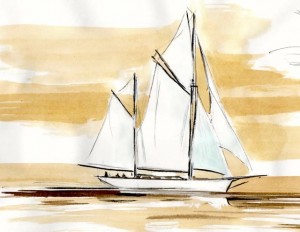 For the past three weeks our correspondents have been aboard two like minded vessels. One, the floating kind, Betty Alan, a fifty foot gaff rigged wooden ketch, slim of line, elegance and strength melded into a romantic symphony of utility and tradition – Joseph Conrad meets Ian Fleming. The other, ‘The Wobbly House’, as coined by my cousin, is a rough patterned weatherboard amalgam of creaking timber floors, exposed bracings and beamery of a maritime pattern.
For the past three weeks our correspondents have been aboard two like minded vessels. One, the floating kind, Betty Alan, a fifty foot gaff rigged wooden ketch, slim of line, elegance and strength melded into a romantic symphony of utility and tradition – Joseph Conrad meets Ian Fleming. The other, ‘The Wobbly House’, as coined by my cousin, is a rough patterned weatherboard amalgam of creaking timber floors, exposed bracings and beamery of a maritime pattern.
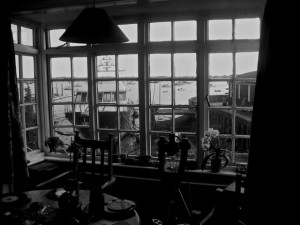 It is set between boat stores, with a mudflat tidal vista of Betty Alan, and a garden of sorts, undesigned, informal, almost weedy. It’s a topographic expression of humanity at its most felt. A combination of ‘Heath Robinson meets Wind in the Willows’ with a bit of Swallows and Amazons for a dash of added authenticity. Both are unashamedly vessels for humans.
It is set between boat stores, with a mudflat tidal vista of Betty Alan, and a garden of sorts, undesigned, informal, almost weedy. It’s a topographic expression of humanity at its most felt. A combination of ‘Heath Robinson meets Wind in the Willows’ with a bit of Swallows and Amazons for a dash of added authenticity. Both are unashamedly vessels for humans.
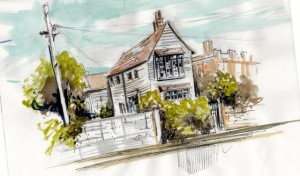 But unlike many modern (and not so modern) boats and homes these vessels share an organic attachment to imperfect humanism. They breathe, and are unimaginable without the reciprocated empathy that seems to exist between vessel and inhabitant.
But unlike many modern (and not so modern) boats and homes these vessels share an organic attachment to imperfect humanism. They breathe, and are unimaginable without the reciprocated empathy that seems to exist between vessel and inhabitant.
I don’t think it’s an accidental conjunction; so who made who?
You see I have some inkling into why these spaces work so well; it is bound in the personalities of the occupants. As Errol Flynn, (our patron) wryly remarked ‘We never own anything ourselves it just passes through us’, but he was talking about paintings. Instead, try this: What I’m talking about are living spaces. After a number of years in the design profession and thinking of Dockland renewals around the world I am brought home to a brutal reality. Houses and boats, are like books. Only when they have been caressed by a sympathetic hand, imbibed by a sympathetic mind, and the ideas and voices within are shared in a symbiosis of mutual regard can there be a ‘transference of soul.’
My cousin is a scientist. I do not understand what she does for a living, I do know she is a ‘Reader in Neurophysiology’ at University College London. 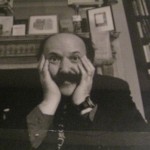 The house she shares with her Antiquarian Book Dealing Partner, is an expression of this. Richard Holmes, in his celebrated book, “The Age of Wonder”* described how artists and scientists intertwined as colleagues in exploring the physical world, a realm in which the likes of Sir Joseph Banks, Hogarth and Reynolds would exchange vigorous debate with their equals in the febrile world of science, Faraday, Hershell, and Watt. From this union, the fruits of enlightenment bloom to this day.
The house she shares with her Antiquarian Book Dealing Partner, is an expression of this. Richard Holmes, in his celebrated book, “The Age of Wonder”* described how artists and scientists intertwined as colleagues in exploring the physical world, a realm in which the likes of Sir Joseph Banks, Hogarth and Reynolds would exchange vigorous debate with their equals in the febrile world of science, Faraday, Hershell, and Watt. From this union, the fruits of enlightenment bloom to this day.
I cannot imagine the interior of either Betty Alan or The Wobbly House without a crowding of people, friends, relatives and children. In Betty Alan the lockers are piled high with books, charts, navigation equipment and coils of rope. As it rocked and pitched on the Atlantic and the North Sea, the proliferation of coats, jackets, tackle and sleeping bags swayed to the hearts that sang, in unison with the breeze through the rigging, across a topography of rolling wave-tops.
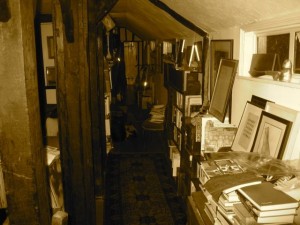 The ‘Wobbly House’, part built, re-built and improvised through its last 400 years, is also a tuning-fork for the onshore breeze. It groans under the weight of books, art, clothing, pots and pans, visitors and the collected miscellany of two very sympathetic minds. I could not imagine them living any other way.
The ‘Wobbly House’, part built, re-built and improvised through its last 400 years, is also a tuning-fork for the onshore breeze. It groans under the weight of books, art, clothing, pots and pans, visitors and the collected miscellany of two very sympathetic minds. I could not imagine them living any other way.
In Australia, our standard definition of housing is non organic, fenced and austere. This by comparison is shared, almost communally without interior walls. (As is much Indigenous housing within Australia) It expresses a dynamic of welcome to those who are prepared to talk, share, observe listen and respect. And somehow that preparedness to exchange, inheritors to ‘The Age of Wonder’, trickles outward along the Quay over the mud-flats and the rest of a very shared public community life that is Burnham on Couch. We have much to learn.
* Richard Holmes. The Age Of Wonder 2008. “ How the Romantic Generation Discovered the Beauty and Terror of Science”. Samuel Johnson Prize and winner of the Royal Society prize for Science Books.

Pingback: Weekly Wrap 12 August 2013 | pcbycp